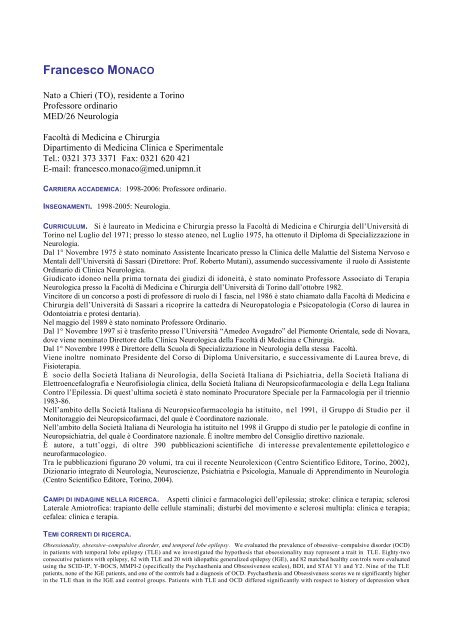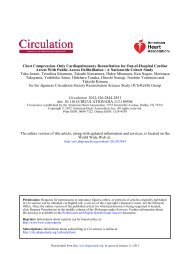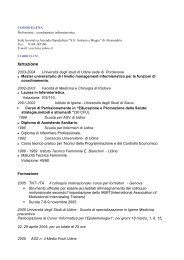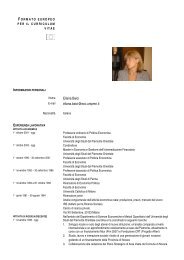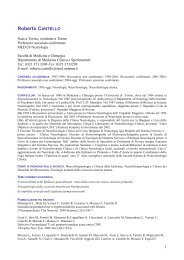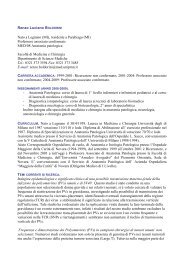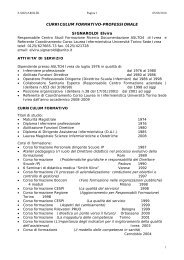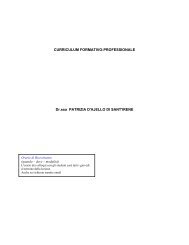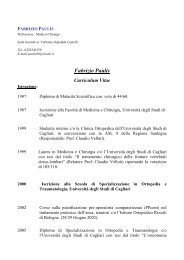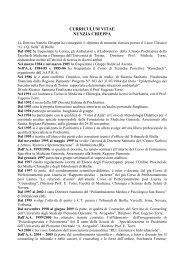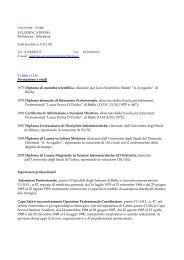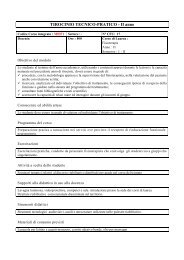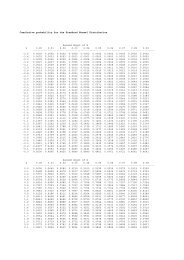Monaco Francesco.pdf - Università del Piemonte Orientale
Monaco Francesco.pdf - Università del Piemonte Orientale
Monaco Francesco.pdf - Università del Piemonte Orientale
You also want an ePaper? Increase the reach of your titles
YUMPU automatically turns print PDFs into web optimized ePapers that Google loves.
<strong>Francesco</strong> MONACO<br />
Nato a Chieri (TO), residente a Torino<br />
Professore ordinario<br />
MED/26 Neurologia<br />
Facoltà di Medicina e Chirurgia<br />
Dipartimento di Medicina Clinica e Sperimentale<br />
Tel.: 0321 373 3371 Fax: 0321 620 421<br />
E-mail: francesco.monaco@med.unipmn.it<br />
CARRIERA ACCADEMICA: 1998-2006: Professore ordinario.<br />
INSEGNAMENTI. 1998-2005: Neurologia.<br />
CURRICULUM. Si è laureato in Medicina e Chirurgia presso la Facoltà di Medicina e Chirurgia <strong>del</strong>l’<strong>Università</strong> di<br />
Torino nel Luglio <strong>del</strong> 1971; presso lo stesso ateneo, nel Luglio 1975, ha ottenuto il Diploma di Specializzazione in<br />
Neurologia.<br />
Dal 1° Novembre 1975 è stato nominato Assistente Incaricato presso la Clinica <strong>del</strong>le Malattie <strong>del</strong> Sistema Nervoso e<br />
Mentali <strong>del</strong>l’<strong>Università</strong> di Sassari (Direttore: Prof. Roberto Mutani), assumendo successivamente il ruolo di Assistente<br />
Ordinario di Clinica Neurologica.<br />
Giudicato idoneo nella prima tornata dei giudizi di idoneità, è stato nominato Professore Associato di Terapia<br />
Neurologica presso la Facoltà di Medicina e Chirurgia <strong>del</strong>l’<strong>Università</strong> di Torino dall’ottobre 1982.<br />
Vincitore di un concorso a posti di professore di ruolo di I fascia, nel 1986 è stato chiamato dalla Facoltà di Medicina e<br />
Chirurgia <strong>del</strong>l’<strong>Università</strong> di Sassari a ricoprire la cattedra di Neuropatologia e Psicopatologia (Corso di laurea in<br />
Odontoiatria e protesi dentaria).<br />
Nel maggio <strong>del</strong> 1989 è stato nominato Professore Ordinario.<br />
Dal 1° Novembre 1997 si è trasferito presso l’<strong>Università</strong> “Amedeo Avogadro” <strong>del</strong> <strong>Piemonte</strong> <strong>Orientale</strong>, sede di Novara,<br />
dove viene nominato Direttore <strong>del</strong>la Clinica Neurologica <strong>del</strong>la Facoltà di Medicina e Chirurgia.<br />
Dal 1° Novembre 1998 è Direttore <strong>del</strong>la Scuola di Specializzazione in Neurologia <strong>del</strong>la stessa Facoltà.<br />
Viene inoltre nominato Presidente <strong>del</strong> Corso di Diploma Universitario, e successivamente di Laurea breve, di<br />
Fisioterapia.<br />
È socio <strong>del</strong>la Società Italiana di Neurologia, <strong>del</strong>la Società Italiana di Psichiatria, <strong>del</strong>la Società Italiana di<br />
Elettroencefalografia e Neurofisiologia clinica, <strong>del</strong>la Società Italiana di Neuropsicofarmacologia e <strong>del</strong>la Lega Italiana<br />
Contro l’Epilessia. Di quest’ultima società è stato nominato Procuratore Speciale per la Farmacologia per il triennio<br />
1983-86.<br />
Nell’ambito <strong>del</strong>la Società Italiana di Neuropsicofarmacologia ha istituito, nel 1991, il Gruppo di Studio per il<br />
Monitoraggio dei Neuropsicofarmaci, <strong>del</strong> quale è Coordinatore nazionale.<br />
Nell’ambito <strong>del</strong>la Società Italiana di Neurologia ha istituito nel 1998 il Gruppo di studio per le patologie di confine in<br />
Neuropsichiatria, <strong>del</strong> quale è Coordinatore nazionale. È inoltre membro <strong>del</strong> Consiglio direttivo nazionale.<br />
È autore, a tutt’oggi, di oltre 390 pubblicazioni scientifiche di interesse prevalentemente epilettologico e<br />
neurofarmacologico.<br />
Tra le pubblicazioni figurano 20 volumi, tra cui il recente Neurolexicon (Centro Scientifico Editore, Torino, 2002),<br />
Dizionario integrato di Neurologia, Neuroscienze, Psichiatria e Psicologia, Manuale di Apprendimento in Neurologia<br />
(Centro Scientifico Editore, Torino, 2004).<br />
CAMPI DI INDAGINE NELLA RICERCA. Aspetti clinici e farmacologici <strong>del</strong>l’epilessia; stroke: clinica e terapia; sclerosi<br />
Laterale Amiotrofica: trapianto <strong>del</strong>le cellule staminali; disturbi <strong>del</strong> movimento e sclerosi multipla: clinica e terapia;<br />
cefalea: clinica e terapia.<br />
TEMI CORRENTI DI RICERCA.<br />
Obsessionality, obsessive–compulsive disorder, and temporal lobe epilepsy. We evaluated the prevalence of obsessive–compulsive disorder (OCD)<br />
in patients with temporal lobe epilepsy (TLE) and we investigated the hypothesis that obsessionality may represent a trait in TLE. Eighty-two<br />
consecutive patients with epilepsy, 62 with TLE and 20 with idiopathic generalized epilepsy (IGE), and 82 matched healthy con trols were evaluated<br />
using the SCID-IP, Y-BOCS, MMPI-2 (specifically the Psychasthenia and Obsessiveness scales), BDI, and STAI Y1 and Y2. Nine of the TLE<br />
patients, none of the IGE patients, and one of the controls had a diagnosis of OCD. Psychasthenia and Obsessiveness scores we re significantly higher<br />
in the TLE than in the IGE and control groups. Patients with TLE and OCD differed significantly with respect to history of depression when
compared with patients with TLE without OCD, whereas there were no differences in age at onset and duration of epilepsy, seizure pattern and<br />
frequency, MRI features, laterality of the EEG focus, antiepileptic drug therapy and combinations, and BDI scores.<br />
Responsiveness to triptans and single nucleotide polymorphisms of the 5HT1B receptor. Single Nucleotide Polymorphisms (SNPs) which do not<br />
encode for diseases states, and therefore have never been under the influence of natural selection, have now emerged as an important component of<br />
individual responses to drugs and may therefore be clinically relevant. Drug metabolism is the not unique site in which genetic polymorphisms might<br />
influence drug action, since differences in the coding or in the non-coding regions of the drug target may also alter drug responses. In the present<br />
study we have investigated whether a SNP located at position -261 of the non coding region of 5HT1B receptor might be able to predict drug<br />
responses to triptans in the acute attack of migraine with or without aura. 48 patients with a diagnosis of migraine were recruited at the Headache<br />
Center of the Department of Neurology A.Avogadro University, Novara. All patients included in the study were prescribed one of 6 triptan<br />
compounds commercializated in Italy. In the follow-up after 3 months patients were classificated as responders or non-responders and divided in 4<br />
groups according to their tolerability to triptan prescribed. Genetic analysis were performed on genomic DNA extracted from EDTA-treated blood<br />
samples. The SNP at position -261 of the 5HT1B receptor gene was analysed by PCR followed by restriction enzyme digestion (Pas I) and gel<br />
electrophoresis. In brief, allele 1, coding for a T at position at -261, was not cut by Pas I, unlikely allele 2, coding for a G. In our migraine population<br />
(48 patients), allele 1 had a frequency 62% and allele 2 had a frequency of 38%. The overall responder rate was 67% and no significant difference<br />
compared to this was observed in TT (56%, n=16) and TG (67%, n=27) patients. Strikingly all GG (100%, n=5) patients were responsive to triptan<br />
treatment. No differences were observed among the groups in side effects and in their severity. In conclusion, our data, althought limited by the small<br />
patients size, suggests that it is possible that a GG genotype might predict high responsivity to triptans and therefore further studies are warranted to<br />
confirm this..<br />
Utilizzo clinico cellule staminali mesenchimali autologhe nella Sclerosi Laterale Amiotrofica. Sono stati al momento reclutati 6 pazienti, tutti<br />
sottoposti alle indagini di follow-up e a biopsia ossea per analisi <strong>del</strong>le cellule staminali mesenchimali. I risultati <strong>del</strong>la crescita cellulare di questi<br />
pazienti sono stati sottoposti a verifica da parte degli esperti <strong>del</strong>l’Istituto Superiore di Sanità che hanno stabilito di escludere dalle procedure di<br />
trapianto il paziente n 1 in cui le cellule presentavano una scarsa vitalità. Il paziente prosegue comunque il follow up clinico. Per i rimanenti pazienti<br />
è stato stabilito di prelevare un quantitativo di midollo osseo proporzionale al logaritmo di crescita al fine di raggiungere il numero minimo di cellule<br />
previsto dal protocollo.Tutti i pazienti sono stati sottoposti, oltre alle procedure previste dal protocollo per il follow up valutativo, a misure<br />
strumentali dinamometriche <strong>del</strong>la forza e a registrazione elettromiografica <strong>del</strong> MUNE al fine di poter disporre <strong>del</strong> maggior numero di misure<br />
obiettive di progressione <strong>del</strong>la malattia. Si comunica altresì che è stato attivato il data base per la terapia genica e cellulare <strong>del</strong>l’Istituto Superiore di<br />
Sanità che viene costantemente aggiornato con tutti i dati relativi ai pazienti reclutati. Per i pazienti 2, 3, 4 e 5 dopo autorizzazione da parte<br />
<strong>del</strong>l’Istituto Superiore di Sanità si è passati alla fase di trapianto. Si informa altresì che a seguito <strong>del</strong>la proposta ministeriale di estendere lo studio ad<br />
altri 5 centri italiani che possano riprodurre fe<strong>del</strong>mente il protocollo in tutte le sue fasi sono state effettuate alcune riunioni c\o l’Istituto Superiore di<br />
Sanità in cui il protocollo è stato presentato dal responsabile <strong>del</strong>la ricerca per quanto riguarda la parte clinica e dalla dottoressa Franca Fagioli per la<br />
parte cellulare ad ematologi e neurologi potenzialmente interessati. Al fine di richiedere tutte le autorizzazioni necessarie, co pia <strong>del</strong> parere di cotesto<br />
comitato etico è stato trasmesso ai ricercatori affinché possa essere allegato alla richiesta di autoriz zazione ai rispettivi comitati etici locali. Al<br />
momento, tuttavia, non sono stati autorizzati dall’ ISS altri Centri..<br />
Consciousness, epilepsy and emotional qualia. The last decade has seen a renaissance of consciousness studies, witnessed by the growing number of<br />
scientific investigations on this topic. The concept of consciousness is central in epileptology, despite the methodological difficulties concerning its<br />
application to the multifaced ictal phenomenology. The authors provide an up-to-date review of the neurological literature on the relationship between<br />
epilepsy and consciousness and propose a bidimensional mo<strong>del</strong> (level vs contents of consciousness) for the description of seizure-induced alterations<br />
of conscious states, accordingly to the findings of recent neuroimaging studies. The neurophysiological correlates of ictal loss and impairment of<br />
consciousness are also reviewed. Special attention is paid to the subjective experiential states associated with medial tempo ral lobe epilepsy. Such<br />
ictal phenomenal experiences are suggested as a paradigm for a neuroscientific approach to the apparently elusive philosophical concept of qualia.<br />
Epilepsy is confirmed to represent a privileged window over basic neurobiological mechanisms of consciousness .<br />
PUBBLICAZIONI PIÙ RECENTI.<br />
F. MONACO. Brain mechanisms of altered conscious states during epileptic seizures. Nat Rev Neurol.<br />
2009;5:267-76.<br />
F. MONACO. Motor cortical organization in an adult with hemimegalencephaly and late onset epilepsy.<br />
Neurosci Lett. 2009;460:126-9.<br />
F. MONACO. The behavioral spectrum of Gilles de la Tourette syndrome. J Neuropsychiatry Clin<br />
Neurosci. 2009;21:13-23.<br />
F. MONACO. Antiepileptic drugs and psychopathology of epilepsy: an update. Epileptic Disord.<br />
2009;11:1-9.<br />
F. MONACO, Neurolexicon, Dizionario integrato di Neurologia, Neuroscienze, Psichiatria e Psicologia, Torino, Centro Scientifico Editore, 2002<br />
F. MONACO, Manuale di Apprendimento in Neurologia, Torino, Centro Scientifico Editore, 2004<br />
F. MONACO, The Role of Aura in Psychopathology and Dissociative Experiences in Epilepsy, in "Int. J. Neuropsychiatry", 2005<br />
F. MONACO, Obsessionality, Obsessive-compulsive Disorder and Temporal Lobe Epilepsy, in "Epilepsy & Behaviour", 2005<br />
F. MONACO, Consciousness, Epilepsy and Emotional Qualia, in "Epilepsy & Behavior", 2005<br />
F. MONACO, P-selectin Glycoprotein Ligand-1 Variable Number of Tandem repeats (VNTR) Polymorphism in Patients with Multiple Sclerosis, in<br />
"Neurosci. Letters", 2005<br />
F. MONACO, The Structured Assessment of Depression in Brain Damaged Individuals (SADBD): Translation and Validation Study of the Italian<br />
Version, in "Neurol Sci", 2005<br />
F. MONACO, E-selectin A561C and G98T Polymorphisms Influence Susceptibility and Course of Multiple Sclerosis, in "J. Neuroimmunol", 2005<br />
F. MONACO, Ostepontin Gene Haplotypes correlate with Multiple Sclerosis Development and Progression, in "J. Neuroimmunol", 2005<br />
F. MONACO, Cerebral Venous Thrombosis: A Retrospective Multicenter Study of 48 Patients, in "Neurol Sci", 2005<br />
Orario di Ricevimento<br />
Mercoledì ore 12-13 in Clinica Neurologica, previo<br />
appuntamento (tel. 0321-3733371)


